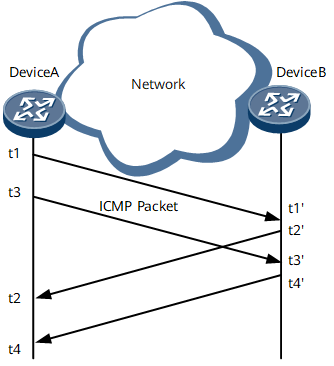ICMP Test
An NQA Internet Control Message Protocol (ICMP) test checks whether the route between an NQA source and a destination is reachable. The ICMP test functions similarly to the ping command. The difference is that the ICMP test can provide detailed output information:
By default, the ping command output contains the results of the five latest tests.
The test results contain information about the average delay time, packet loss ratio, and the time when the last packet was correctly received.
The NQA source (Device A) constructs an ICMP Echo Request message, sends it to destination router B, and adds timestamp t1.
Upon receipt, the destination responds to the NQA source with an ICMP Echo Reply message and adds timestamp t2 to calculate the time it takes to communicate between the NQA source and the destination by subtracting the time when the NQA source received the ICMP Echo Reply message from the time the NQA source sent the ICMP Echo Request message.
The data obtained is used to evaluate the network status.
Delay = t2 – t1
If the delay is longer than the specified timeout period, the network is congested and ICMP packets will be counted as lost packets.
An ICMP test can also measure the packet loss rate using the following formula: Packet loss rate = Number of lost ICMP packets/Number of sent ICMP packets
The packet loss rate further reflects network status.
